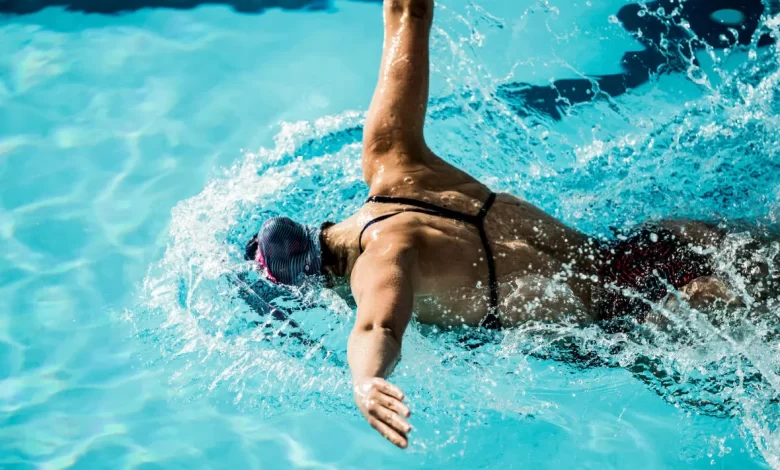Swimming: a physical benefits

Swimming is a broad term that refers to the action of swimming, whether on the surface or underwater. It encompasses the different physical activities practiced in the water: diving, synchronized swimming, diving, etc. An Olympic discipline since 1896 for men and 1912 for women, swimming remains a sport accessible to all.
The offer in terms of aquatic sports activities is wide and tends to diversify even more. Whether it’s water aerobics, aquake, water yoga or simple swimming, anyone can practice a sport in the water. 2 to 3 weekly sessions are recommended for maximum benefit lifeguard training.
A sports activity without impact on the joints
One of the first benefits of swimming is certainly the absence of impact on the joints and on the back, which means that this sport can be adopted at all ages. Studies have also shown that the practice of an aquatic activity soothes the pain associated with arthritis and osteoarthritis while strengthening the joints 1-2 . Swimming also helps preserve and even improve bone health in women going through perimenopause or menopause 3 . By practicing this type of sport, people in good physical shape will protect themselves against possible pain in the joints.
Tone your muscles without pain
Moreover, an additional load of weight is not necessary since the aquatic medium itself provides resistance. Men who, for 8 weeks, trained according to a swimming program increased their muscle mass in the triceps by 23.8% 4 . Regular swimming helps to tone the muscles of the arms, legs and trunk.
The forms of swimming are multiple and allow to work different muscles. Here are 4 techniques:
The breaststroke. It mainly solicits the biceps, pectorals, abdominals and calves. Hands are joined at chest height. They are then pushed forward to full arm extension. Then, they separate, run along each side of the body and rejoin at the initial position. During this time, the legs perform a breaststroke scissor which consists of bringing the heels closer to the buttocks and then performing a propulsion in the manner of a frog jump. The faster this combination of movements, the more powerful the momentum will be.
The crawl. Easy to perform, the crawl allows you to swim quickly. While the legs alternately kick, the arms are alternately out of the water. The palm of the hand must be facing the water when diving in order to promote propulsion. This type of swimming helps to tone all the muscles: arms, shoulders, legs, chest and abs.
The backstroke. This practice effectively works the back muscles. The movements are the same as for the front crawl except that the back faces the water rather than the chest. The major difficulty of the backstroke is to stay in the initial trajectory.
The butterfly. The undulating movements of butterfly-type swimming allow you to strengthen your abdominal muscles in depth. However, it is the most difficult technique to master because it requires perfect coordination. The legs must undulate in such a way as to propel the trunk out of the water. When coming out of the water, the arms are open in a U-shape and the palms must go down first. Once the arms have entered the water, they should be pushed back towards the waist. This sequence must be repeated continuously.
Better cardiovascular and respiratory capacities
In addition to calling on all the muscles of the body (biceps, triceps, abdominals, quadriceps, etc.), swimming solicits the respiratory system and cardiovascular capacities. It is one of the most effective physical activities to improve venous return. Due to the contraction and relaxation of the muscles, the various movements performed promote blood circulation while limiting water retention. This is particularly beneficial for the legs which are frequently affected. By swimming regularly, the heart will offer increased power and resistance. Swimming thus makes it possible to limit the risk of cardiovascular disease since, both at rest and during exercise, the work of the heart is facilitated.
Mental health benefits
Thus, tensions and stress evaporate, giving way to a feeling of well-being. These hormones act on the brain, spinal cord and digestive system to bring the person into a state of bliss.
Sources
Westby MD. 2001. A health professional’s guide to exercise prescription for people with arthritis: a review of aerobic fitness activities. Arthritis Care and Res. 45(6):501-11. Bartels EM, Lund H, Hagen KB, Defraud H, Christensen R, Danneskiold-Samsøe B. 2007. Aquatic exercise for the treatment of knee and hip osteoarthritis. Cochrane Database of Systematic Reviews. 4:1-9. Rothstein A, Haresh M, and Viessman N. 2008. The effect of water exercise program on bone density of postmenopausal Women. J Sports Med Phys Fitness. 48(3):352-9. Lavoie, J.M., et al. Skeletal muscle fiber size adaptation to an eight-week swimming programmed. Eur J Appl Physio Occupy Physiol. 1980;44(2):161-5. B.G. Berger, D.R. Owen. Mood alteration with swimming–swimmers really do “feel better”. Psychosomatic Medicine October 1, 1983 vol. 45 no. 5 425-433




